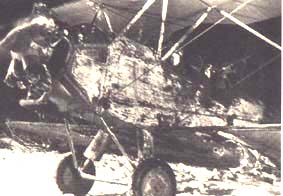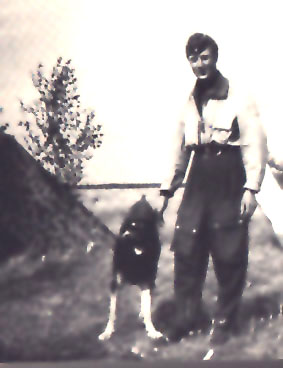
Soviet "Night Witches" over the Caucasus.


A constant cause of stress to the poor remnants of the Luftwaffe in the Caucasus
during the fall of 1942 were the incessant Soviet nocturnal air raids.
In October 1942, Feldwebel Werner Hohenberg of 8./JG 52 wrote:
"Intense Soviet night air activity, and in daylight we experience the first low-level attacks by Il-2s against our airfield."
Among the Soviet light night bomber units active in this area was the all-women 588 NBAP (Night Bomber Aviation Regiment), equipped with U-2s. The courage displayed by these women soon earned them the nickname "Night witches" on the German side. According to Alfred Grislawski, who served as an Oberfeldwebel with III./JG 52 in the Caucasus, this nickname was invented by the men of III./JG 52 by that time.
After the war, Starshiy Leytenant Serafima Amosova-Taranenko, told U.S. author Anne Noggle about her experiences in the Caucasus during this period:
"On one airfield where we were stationed there were two regiments, one female and one male. We had the same missions. The same aircraft, and the same targets, so we worked together. The female regiment performed better and made more combat flights each night than the male regiment. (…) Once one of the German prisoners said, “When the women started bombing our trenches we (Germans) had a number of radio nets, and the radio stations on this line warned all their troops, ‘Attention, attention, the ladies are in the air, stay at your shelter.’ (…)
"Nobody knows the exact date when they started calling us night witches. We were fighting in the Caucasus near the city of Mozdok; on one side of this city were Soviet troops and on the other, German. We were bombing the German positions nearly every night…"
(Noggle, A Dance with Death; Soviet Airwomen in World War II, p. 46.)
Hauptmann Johannes Steinhoff, the commander of II./JG 52 who was awarded the Oak Leaves to the Knight’s Cross for 101 victories on September 2, 1942, wrote:
‘We simply couldn’t graps that the Soviet airmen that caused us the greatest trouble were in fact WOMEN. These women feared nothing. They came night after night in their very slow biplanes, and for some periods they wouldn’t give us any sleep at all.’

On most occasions, the the poor bombing and navigational devices of
the "Night Witches" prevented them from dealing any heavy material
damage to the enemy. But on the night of October 25, 1942, a lucky bomb strike
set a fuel depot at the airfield of Armavir ablaze. The fire spread, and six
Ju 88s of Stab and II./KG 51 were destroyed. Only one aircraft escaped damage.
This lead to the quick withdrawal of II./KG 51 to the Kerch Peninsula.
It was hard for the Germans to adopt any effective counter-measures against the U-2s, whose cruising speed was below that of the Bf 109. Alfred Grislawski recounts how the newcomer Leutnant Erich Hartmann once set up a 20mm-antiaircraft gun against the U-2 intruders - with the only result that the gun's muzzle fire served as aiming point for the U-2 crew, and Hartmann barely escaped from getting himself killed by the dropped bombs.
Fliegerkorps IV organized improvised night-fighter units with He 111s from Kampfgeschwader and Bf 110s from 10./ZG 1. Operating with the support of searchlights, these night fighters occasionally took a heavy toll of the biplanes. When hit, the U-2 aircraft was easily set on fire, and the plane was almost always doomed. The crew could not escape, because parachutes were not provided until the summer of 1944.
The most successful night-fighter pilot of 10.(NJ)/ZG 1 during this period was Oberfeldwebel Josef Kociok, who was credited with 21 night kills. On one single night, he destroyed four U-2s in a row. Serafima Amosova witnessed this event:
"One night, as our aircraft passed over the target, the searchlights came on, the antiaircraft guns were firing, and then a green rocket was fired from the ground. The antiaircraft guns stopped, and a German fighter plane came and shot down four of our aircraft as each one came over the target. Our planes were burning like candles. We all witnessed this scene. When we landed and reported that we were being attacked by German fighters, they would not let us fly again that night. We lived in a school building with folding wooden beds. You can imagine our feelings when we returned to our quarters and saw eight beds folded, and we knew they were the beds of our friends who perished a few hours ago."
Oberfeldwebel Josef Kociok was awarded with the Knight’s Cross. Later he was killed in action near Kerch when he collided with a crashing Russian aircraft and his parachute failed to open.
The U-2 - later designated Po-2 - had the lowest loss rate among all Soviet combat aircraft during World War II. It later served with success during the Korea war, providing the Americans with the same difficulties as the Germans had experienced ten years previously.
Sources:
Noggle, A Dance with Death; Soviet Airwomen in World War II.
Interviews with Werner Hohenberg, Alfred Grislawski, and Johannes Steinhoff.
Misc. material kindly provided by Åke Andersson, "Po-2-pilot" in Eskilstuna/Sweden.